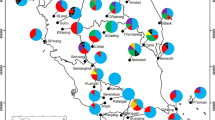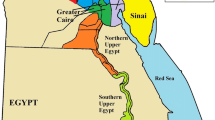Abstract
The main goals of this study were to isolate microsatellites markers of Korean water deer (Hydropotes inermis argyropus) and understand the genetic status of the species in South Korea. Twelve new microsatellite loci were isolated and characterized to establish basic population genetic parameters for 45 H. i. argyropus specimens in South Korea. There were no significant regional or genetic structure differences between the mid-eastern and southwestern populations in South Korea according to the population genetic analyses. The number of alleles per locus ranged from two to 13 with an average of 6.08. Mean expected (H E) and observed heterozygosity (H O) were 0.622 and 0.533, respectively. Microsatellite variability was also not significant between the two regions (F ST=0.012). These new markers should facilitate the future population genetics studies of Korean water deer and other closely related species.
Similar content being viewed by others
References
Allen G.M. (1940) Mammals of china and mongolia. Natural History of Central Asia, American Museum of Natural History, New York, pp. 1126–1261.
Beaumont MA and Bruford MW (1998) Microsatellites in conservation genetics. Oxford University Press, New York, pp. 165–182.
Bowcock AM, Ruiz-Linares A, Tomfohrde J, Minch E, Kidd JR and Cavalli-Sforza LL (1994) High resolution of human evolutionary trees with polymorphic microsatellites. Nature 368; 455–457.
Broders HG, Mahoney SP, Montevecchi WA and Davidson WS (1999) Population genetic structure and the effect of founder events on the genetic variability of moose, Alces alces, in Canada. Mol. Ecol. 8: 1309–1315.
Bruford MW and Wayne RK (1993) Microsatellites and their application to population genetic studies. Genom. Evol. 3: 939–942.
Buchanan FC, Friesen MK, Littlejohn RP and Clayton JW (1996) Microsatellites from the beluga whale Delphinapterus leucas. Mol. Ecol. 5: 571–575.
Butzler W (1990) Grzimek’s encyclopedia mammals. Vol 5, McGraw-Hill Publishing Company, New York.
Cook A and Farrell L (1998) Chinese water deer. The Mammal Society and the British Deer Society, London.
Geist V (1998) Deer of the world. In evolution, behaviour and ecology, Stackpole Books, Mechanicsburg.
Goudet, J (1995) FSTAT, Version 1.2, a computer program to calculate F-statistics. J. Hered. 86: 485–486.
Grubb P (2005) Mammal species of the world: a taxonomic and geographic reference. In Order Artiodactyla, E.E. Wilson and M.D. Reeder, eds., Smithsonian Institution Press, New York, pp. 637–722.
Harris RB and Duckworth JW (2008) Hydropotes inermis. In IUCN 2010, IUCN Red List of Threatened Species Version 2010.
Heude (1884) Hydropotes inermis argyropus. Comptes rendus des Séances de l’Académie des Sciences Compt, xxviii, Paris, 107 pp.
Hu J, Pana HJ, Wana QH and Fang SG (2007) Nuclear DNA microsatellite analysis of genetic diversity in captive populations of Chinese water deer. Small Rumin. Res. 67: 252–256.
Kalinowski ST, Taper ML and Marshall TC (2007) Revising how the computer program CERVUS accommodates genotyping error increases success in paternity assignment. Mol. Ecol. 16: 1099–1106.
Kim KS and Sappington TW (2004) Isolation and characterization of polymorphic microsatellite loci in the boll weevil, Anthonomus grandis Boheman (Coleoptera: Curculionidae). Mol. Ecol. Notes 4: 701–703.
Kim KS, Yeo JS and Choi CB (2002a) Genetic diversity of north-east Asian cattle based on microsatellite data. Anim. Genet. 33: 201–204.
Kim KS, Yeo JS, Lee JW, Kim JW and Choi CB (2002b) Genetic diversity of goats from Korea and China using microsatellite analysis. Asian-Australasian J. Anim. Sci. 15: 461–465.
Kim KS, Min MS, An J and Lee H (2004) Cross-species amplifications of bovidae microsatellites and low diversity of the endangered Korean goral. J. Hered. 95: 521–525.
Kim TH, Kim KS, Choi BH, Yoon DH, Jang GW, Lee KT, Chung HY, Lee HY, Park HS and Lee JW (2005) Genetic structure of pig breeds from Korea and China using microsatellite loci analysis. J. Anim. Sci.83: 2255–2263.
Kim BJ, Oh DH, Chun SH and Lee SD (2010) Distribution, density, and habitat use of the Korean water deer (Hydropotes inermis argyropus) in Korea. Landsc. Ecol. Eng. 1-7–7.
Koh HS, Lee BK, Wang J, Heo SW and Jang KH (2009) Two sympatric phylogroups of the Chinese water deer (Hydropotes inermis) identified by mitochondrial DNA control region and cytochrome b gene analyses. Biochem. Genet. 47: 860–867.
Koh HS and Randi E (2001) Genetic distinction of roe deer (Capreolus pygargus pallas) sampled in korea. Mamm. boil. 66: 371–375.
Lee BK (2003) Morphological, ecological and DNA taxonomic characteristics of Chinese water deer (Hydropotes inermis Swinhoe). PhD thesis, Chungbuk National University, Korea.
Polziehn RO, Hamr J, Mallory FF and Strobeck C (2000) Micriosatellite analysis of North American wapiti (Cervus elaphus) populations. Mol. Ecol. 9: 1561–1576.
Pritchard JK, Stephens M and Donnelly P (2000) Inference of population structure using multilocus genotype data. Genetics 155: 945–959.
Raymond M and Rousset F (1995) GENEPOP version 4.0: population genetics software for exact tests and ecumenicism. J. Hered. 86: 248–249.
Rice WR (1989) Analyzing tables of statistical tests. Evolution 43: 223–225.
Røed KH (1998) Microsatellite variation in Scandinavian Cervidae using primers derived from Bovidae. Hereditas 129: 19–25
Ronald JS, David AV, Franklin WL, O’Brien SJ and Johnson WE (2000) Development of microsatellite markers in the guanaco, Lama guanicoe: utility for South American camelids. Mol. Ecol. 9: 1992–1924.
Rozen S and Skaletsky H (2000) Primer3 on the www for general users and for biologist programmers. In Methods in Molecular Biology, S. Misener and S.A. Krawetz, eds., Humana Press, Totowa, pp. 365–386.
Schuelke M (2000) An economic method for the fluorescent labeling of PCR fragments. Nature Biotech. 18: 233–234.
Swinhoe R (1870) On a new from China plates. VI&VII, pp. 89–92.
Valerius G. (1998) Deer of the world. Stackpole books, pp. 26–28.
Wang S (1998) China red data book of endangered animals. Mammal Volume, Science Press, Beijing.
Weir BS and Cockerham CC (1984) Estimating F-statistics for the analysis of population structure. Evolution 38: 1358–1370.
Won CM and Smith KG (1999) History and current status of mammals of the Korean peninsula. Mammal Rev. 29: 3–36.
Won PH (1967) Illustrated encyclopedia of fauna and flora of Korea. Mammals, Ministry of Education, Seoul.
Woo HC, Lee JI, Son SW and Park HS (1990) Ecological survey of mammals in South Korea. IV, Ministry of Environment, Seoul.
Zhang ED and Guo GP (2000) Poaching as a major threat on Chinese water deer in Zhoushan Archipelago. Deer 11: 413–414.
Author information
Authors and Affiliations
Corresponding authors
Additional information
Y.-S. Lee and S.-K. Choi contributed equally to this work.
Rights and permissions
About this article
Cite this article
Lee, YS., Choi, SK., An, J. et al. Isolation and characterization of 12 microsatellite loci from Korean water deer (Hydropotes inermis argyropus) for population structure analysis in South Korea. Genes Genom 33, 535–540 (2011). https://doi.org/10.1007/s13258-010-0166-7
Received:
Accepted:
Published:
Issue Date:
DOI: https://doi.org/10.1007/s13258-010-0166-7




